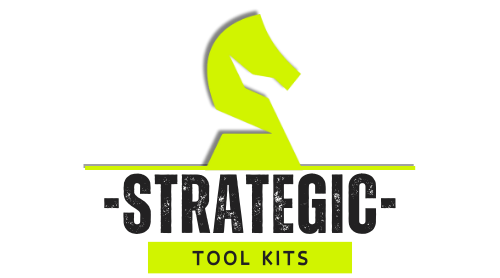Strategic leadership drives business growth by setting a clear vision and fostering an innovative culture. This article outlines ten principles that successful leaders use to achieve these goals.
By implementing these strategies, businesses can enhance performance, encourage creativity, and maintain a competitive edge. Let’s explore these tenets that define effective strategic leadership and their profound impact on organizational success.
1. Distribute Responsibility

Distributing responsibility is a cornerstone of strategic leadership that drives business growth. This principle focuses on empowering employees at all levels to take ownership of their roles and contribute to the organization’s success.
Empowering Employees
When leaders distribute responsibility, they empower employees to make decisions, solve problems, and take initiative. This empowerment boosts morale, fosters a sense of ownership, and encourages employees to contribute their best efforts. It creates a dynamic where everyone feels valued and motivated to work towards the company’s goals.
Building Trust and Collaboration
Distributing responsibility builds trust between leaders and their teams. It shows that leaders have confidence in their employees’ abilities and judgment. This trust is crucial for fostering collaboration and open communication, which are essential for innovation and problem-solving. Employees are more likely to share ideas and collaborate when they feel trusted and respected.
Enhancing Efficiency and Innovation
By distributing responsibility, organizations can enhance efficiency and innovation. Employees who are closer to the day-to-day operations often have valuable insights and ideas that can lead to improvements and innovations.
When these employees are given the responsibility to act on their insights, the organization can implement changes more quickly and effectively.
Practical Steps
To effectively distribute responsibility, leaders can:
- Delegate Tasks Based on Strengths: Assign tasks to employees based on their skills and strengths to ensure that they can perform effectively and confidently.
- Provide Resources and Support: Equip employees with the necessary resources and support to make informed decisions and take action.
- Encourage Decision-Making: Create an environment where employees feel comfortable making decisions and understand that their input is valued.
- Recognize and Reward Efforts: Acknowledge and reward employees for their contributions and successes to reinforce positive behavior and outcomes.
2. Be Honest and Open About Information
Being honest and open about information is a key principle of strategic leadership. Transparency in communication builds trust, fosters a culture of openness, and ensures that everyone in the organization is aligned and informed.
Fostering Trust and Transparency
Honesty and openness in information sharing build trust between leaders and employees. When leaders communicate openly, it shows that they value their team members and respect their right to be informed. This trust is essential for creating a cohesive and motivated workforce.
Encouraging Open Communication
Open communication means that information flows freely within the organization. Employees at all levels should feel comfortable sharing their ideas, feedback, and concerns. This openness leads to better decision-making, as leaders have access to a wide range of perspectives and insights.
Aligning the Organization
When information is shared openly, it ensures that everyone in the organization is on the same page. Clear communication of goals, strategies, and progress helps align the efforts of all team members, making it easier to work towards common objectives. This alignment is crucial for achieving strategic goals and driving business growth.
Practical Steps
To be honest and open about information, leaders can:
- Communicate Regularly: Hold regular meetings and updates to share important information about the organization’s goals, progress, and challenges.
- Encourage Feedback: Create channels for employees to provide feedback and ask questions. This can include suggestion boxes, surveys, or open-door policies.
- Share Successes and Failures: Be transparent about both successes and failures. Celebrating successes boosts morale while discussing failures openly helps the organization learn and improve.
- Provide Access to Information: Ensure that employees have access to the information they need to do their jobs effectively. This can include sharing data, reports, and other resources.
3. Create Multiple Paths for Raising and Testing Ideas

Creating multiple paths for raising and testing ideas is a vital principle of strategic leadership. It encourages innovation, enhances problem-solving capabilities, and fosters a culture where creativity can thrive.
Encouraging Innovation
Innovation is the lifeblood of any successful organization. By providing various channels through which employees can present and test their ideas, leaders can tap into the collective creativity of their workforce. This approach ensures that innovative ideas are not lost and can be developed into actionable strategies.
Building a Culture of Creativity
A culture that supports creativity is essential for generating new ideas. Leaders can establish cross-functional forums, brainstorming sessions, and innovation labs where employees feel safe to share their thoughts. Encouraging diverse perspectives and collaborative thinking helps in refining ideas and turning them into viable solutions.
Improving Problem-Solving
When multiple paths for raising ideas are available, employees are more likely to engage in problem-solving. They can bring forward their unique insights and propose solutions that might not have been considered otherwise. This inclusivity enhances the organization’s ability to address challenges effectively.
Practical Steps
To create multiple paths for raising and testing ideas, leaders can:
- Establish Innovation Forums: Create regular forums where employees from different departments can come together to brainstorm and share ideas.
- Encourage Cross-Functional Teams: Form teams with members from various functions to work on specific projects or problems. This diversity in thinking leads to more comprehensive solutions.
- Implement Idea Management Systems: Use digital platforms that allow employees to submit, discuss, and vote on ideas. These systems can track the progress of ideas from inception to implementation.
- Provide Mentorship Opportunities: Set up mentorship programs where experienced leaders can guide employees in developing and testing their ideas.
- Celebrate Creativity: Recognize and reward employees who contribute innovative ideas. This recognition can motivate others to participate actively in the ideation process.
4. Make it Safe to Fail
Creating an environment where it is safe to fail is a crucial principle of strategic leadership. This approach encourages experimentation, fosters innovation, and ensures continuous learning within the organization.
Encouraging Experimentation
When employees know they can try new ideas without fear of punishment for failure, they are more likely to experiment and take risks. This experimentation is essential for innovation, as it allows the organization to explore new possibilities and find creative solutions to problems.
Learning from Failures
Failures are inevitable in any innovative process. However, they provide valuable learning opportunities. By analyzing what went wrong and why, employees and leaders can gain insights that help improve future efforts. Embracing failure as a learning tool fosters a culture of continuous improvement.
Reducing Fear and Increasing Engagement
An environment that makes it safe to fail reduces fear among employees. When employees are not afraid of negative consequences, they are more engaged and willing to contribute their ideas. This engagement leads to a more dynamic and innovative workplace.
Practical Steps
To make it safe to fail, leaders can:
- Promote a Growth Mindset: Encourage employees to view failures as opportunities to learn and grow. This mindset shift can be achieved through training and consistent messaging from leadership.
- Set Clear Expectations: Define acceptable risks and set boundaries for experimentation. Employees should know which areas they have the freedom to explore and what the potential impacts might be.
- Share Stories of Failure and Success: Regularly share examples of both failures and successes within the organization. Highlight what was learned from failures and how they contributed to eventual success.
- Provide Constructive Feedback: Offer feedback that focuses on what can be improved rather than solely on what went wrong. Constructive feedback helps employees learn and develop their skills.
- Reward Innovation Efforts: Recognize and reward employees who take the initiative and propose new ideas, even if those ideas do not always succeed. This recognition reinforces the value of innovation and risk-taking.
5. Provide Access to Other Strategists

Providing access to other strategists is essential for enhancing collaboration and broadening perspectives within an organization. This principle helps develop strategic capabilities across the team, leading to better decision-making and innovation.
Enhancing Collaboration
When employees can interact with other strategists, they can exchange ideas and best practices. This interaction leads to more effective teamwork and problem-solving, which is essential for achieving strategic objectives.
Broadening Perspectives
Exposure to different viewpoints and strategies helps employees think creatively and consider alternative solutions. This diversity of thought is crucial for developing robust strategies that drive growth.
Developing Strategic Skills
Access to experienced strategists helps employees enhance their strategic thinking skills. Learning from others’ experiences and insights ensures the organization has a strong pool of strategic leaders ready to tackle future challenges.
Practical Steps
To provide access to other strategists, leaders can:
- Create Networking Opportunities: Organize regular networking events, workshops, and seminars where employees can meet and interact with strategists from different departments or organizations.
- Establish Mentorship Programs: Pair employees with experienced strategists who can provide guidance, share insights, and help them develop their strategic thinking skills.
- Encourage Cross-Departmental Projects: Promote projects that require collaboration between different departments. These projects allow employees to work with strategists from various areas of the organization, leading to cross-functional learning and innovation.
- Leverage Technology: Use collaboration tools and platforms to facilitate communication and idea-sharing among strategists, regardless of their location. Virtual meetings, discussion forums, and shared workspaces can help bridge geographical and departmental gaps.
- Recognize and Reward Collaboration: Acknowledge and reward employees who actively collaborate and contribute to strategic initiatives. Recognition can motivate others to engage in collaborative efforts and share their strategic insights.
6. Develop the Skills of Others
Developing the skills of others is a key principle of strategic leadership. It focuses on ensuring that employees have the capabilities and knowledge they need to contribute effectively to the organization’s goals.
Investing in Training and Development
Providing ongoing training and development opportunities helps employees stay updated with the latest industry trends and skills. This investment in education not only enhances individual performance but also boosts the overall productivity and competitiveness of the organization.
Encouraging Continuous Learning
Encouraging a culture of continuous learning ensures that employees are always improving and evolving. Leaders should promote lifelong learning and provide resources such as workshops, online courses, and certifications to help employees expand their skills.
Building a Talent Pipeline
Developing the skills of employees also means preparing them for future leadership roles. By identifying high-potential individuals and providing them with the necessary training and mentorship, organizations can build a strong pipeline of future leaders.
Practical Steps
To develop the skills of others, leaders can:
- Provide Regular Training Programs: Offer a variety of training programs, including in-house workshops, online courses, and external seminars. Ensure that these programs cover both technical skills and soft skills such as communication and leadership.
- Encourage Mentorship: Establish mentorship programs where experienced employees can guide and support less experienced ones. This helps in knowledge transfer and personal development.
- Set Development Goals: Work with employees to set specific, measurable development goals. Regularly review progress and provide feedback to help them stay on track.
- Create Learning Opportunities: Encourage employees to take on challenging projects or roles that push them out of their comfort zones. This hands-on experience is invaluable for skill development.
- Recognize and Reward Growth: Acknowledge and reward employees who show significant growth and improvement in their skills. Recognition can motivate others to pursue their own development.
7. Keep the Focus on Big-Picture Goals

Keeping the focus on big-picture goals is a critical principle of strategic leadership. It ensures that all efforts and resources are aligned with the organization’s long-term vision and objectives.
Aligning Efforts with Vision
Strategic leaders must ensure that every team and department understands the organization’s overarching goals. This alignment helps in maintaining a unified direction, where all efforts contribute to the larger mission. Clear communication of these goals is essential for keeping everyone on track.
Prioritizing Key Objectives
Focusing on big-picture goals requires prioritizing key objectives over day-to-day tasks. Leaders should help their teams identify the most critical projects and initiatives that will drive the organization forward. This prioritization ensures that resources are allocated efficiently and effectively.
Avoiding Distractions
It is easy for teams to get sidetracked by minor issues or immediate concerns. Strategic leaders must help their teams avoid these distractions by consistently reminding them of the big-picture goals. Regular check-ins and progress reviews can keep the team focused and aligned with the long-term objectives.
Practical Steps
To keep the focus on big-picture goals, leaders can:
- Communicate the Vision Clearly: Regularly share the organization’s vision and strategic goals with all employees. Ensure that these are well-understood and integrated into daily operations.
- Set Milestones and Track Progress: Break down the big-picture goals into smaller, manageable milestones. Track progress towards these milestones and celebrate achievements to maintain momentum.
- Encourage Long-Term Thinking: Promote a culture that values long-term success over short-term gains. Encourage employees to think about how their actions contribute to the overall mission.
- Provide Strategic Guidance: Offer regular strategic guidance and support to help teams stay focused. This includes helping them navigate challenges and avoid getting bogged down by less important tasks.
- Evaluate and Adjust: Periodically review the organization’s progress toward its big-picture goals. Be willing to adjust strategies and objectives as needed to stay on course.
8. Ensure Timely Decision Making
Ensuring timely decision-making is a key principle of strategic leadership. It helps maintain momentum, prevents stagnation, and allows the organization to adapt quickly to changing circumstances.
Maintaining Momentum
Timely decisions are crucial for keeping projects and initiatives moving forward. When decisions are delayed, it can lead to bottlenecks and slow down progress. Leaders must ensure that decision-making processes are efficient to maintain momentum and achieve strategic goals on schedule.
Adapting to Change
In a dynamic business environment, the ability to make quick decisions is essential for adapting to new opportunities and challenges. Timely decision making allows organizations to be agile and responsive, ensuring they remain competitive and can capitalize on emerging trends.
Reducing Uncertainty
Delays in decision making can create uncertainty and confusion within the organization. By making timely decisions, leaders provide clarity and direction, helping employees stay focused and aligned with the company’s objectives. This reduces anxiety and increases confidence among team members.
Practical Steps
To ensure timely decision making, leaders can:
- Streamline Decision-Making Processes: Simplify and standardize processes to make decision-making more efficient. This can include setting clear criteria for decisions, reducing unnecessary steps, and empowering employees to make decisions within their scope of responsibility.
- Set Deadlines: Establish specific deadlines for decisions to prevent procrastination and ensure timely action. Clear timelines help keep everyone accountable and focused.
- Delegate Authority: Empower team members to make decisions within their areas of expertise. Delegating authority not only speeds up the decision-making process but also builds trust and confidence among employees.
- Use Data-Driven Approaches: Base decisions on solid data and analysis. This reduces the time spent deliberating and increases the likelihood of making effective choices.
- Communicate Decisions Clearly: Once a decision is made, communicate it promptly and clearly to all relevant parties. This ensures that everyone is on the same page and can act on the decision without delay.
9. Balance Innovation and Operational Efficiency

Balancing innovation and operational efficiency is a vital principle of strategic leadership. It ensures that while the organization continues to innovate and grow, it also maintains high levels of operational performance.
Encouraging Innovation
Innovation is essential for staying competitive and driving growth. Leaders must create an environment where employees feel encouraged to think creatively and propose new ideas. This can be achieved by providing resources for research and development, fostering a culture of experimentation, and recognizing and rewarding innovative efforts.
Maintaining Operational Efficiency
Operational efficiency ensures that the organization runs smoothly and effectively. Leaders need to implement efficient processes and systems, optimize resource utilization, and eliminate waste. By maintaining high operational standards, organizations can deliver quality products and services while controlling costs.
Finding the Balance
Balancing innovation and operational efficiency involves finding the right mix of exploration and exploitation. Leaders should allocate resources to both areas, ensuring that neither is neglected. This balance allows the organization to innovate while maintaining a stable operational foundation.
Practical Steps
To balance innovation and operational efficiency, leaders can:
- Allocate Resources Wisely: Distribute resources between innovative projects and core operational activities. Ensure that both areas receive adequate support to thrive.
- Set Clear Objectives: Define clear goals for both innovation and operational efficiency. This helps employees understand the importance of both areas and work towards them simultaneously.
- Implement Efficient Processes: Develop and refine processes that streamline operations without stifling innovation. Efficient processes help maintain high performance while allowing room for creative thinking.
- Encourage Cross-Functional Collaboration: Foster collaboration between teams focused on innovation and those focused on operations. This can lead to the sharing of best practices and the integration of innovative ideas into everyday operations.
- Monitor and Adjust: Regularly assess the balance between innovation and operational efficiency. Be prepared to adjust strategies and resource allocation as needed to maintain an optimal balance.
10. Promote a Growth Mindset

Promoting a growth mindset is an essential principle of strategic leadership. It involves fostering an attitude of continuous improvement and resilience, encouraging employees to embrace challenges and view failures as opportunities to learn and grow.
Embracing Challenges
A growth mindset encourages employees to take on new challenges without fear of failure. Leaders can promote this attitude by highlighting the importance of learning from experiences and pushing beyond comfort zones. This mindset helps individuals and teams to innovate and improve continuously.
Learning from Failures
Viewing failures as learning opportunities is a cornerstone of a growth mindset. Leaders should create an environment where employees feel safe to experiment and make mistakes. By analyzing and understanding failures, employees can gain valuable insights and apply them to future endeavors.
Encouraging Persistence
A growth mindset emphasizes the value of persistence and effort. Leaders can motivate employees to keep trying, even when faced with setbacks. Recognizing and celebrating perseverance helps build a culture of resilience and determination.
Practical Steps
To promote a growth mindset, leaders can:
- Model Growth Mindset Behaviors: Demonstrate a growth mindset in their own actions by embracing challenges, learning from failures, and showing persistence. Leaders who model these behaviors set a positive example for their teams.
- Provide Learning Opportunities: Offer continuous learning and development programs, such as workshops, training sessions, and mentorship opportunities. Encourage employees to pursue new skills and knowledge.
- Celebrate Effort and Progress: Recognize and reward effort, improvement, and progress, rather than just outcomes. This reinforces the idea that growth and learning are valuable and worth striving for.
- Create a Safe Environment for Risk-Taking: Encourage experimentation and calculated risk-taking. Make it clear that mistakes are part of the learning process and provide support for employees to recover and learn from them.
- Give Constructive Feedback: Provide feedback that focuses on development and growth. Help employees understand how they can improve and support them in their efforts to do so.
Last Words
Strategic leadership is essential for driving business growth and ensuring long-term success. Leaders can create a resilient and dynamic organization by delegating responsibility, promoting transparency, supporting innovation, and encouraging continuous learning.
These strategies help align teams with the company’s goals, enhance decision-making, and balance the need for innovation with operational efficiency.

